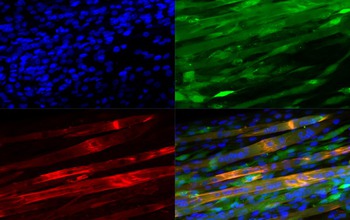Engineering muscles and organs in space

Muscle fibers grown on scaffolds outside the body could help identify future medical treatments.
August 2, 2018
The National Science Foundation (NSF) has invested in two projects for fundamental biomedical engineering research onboard the International Space Station (ISS) U.S. National Laboratory for the benefit of life on Earth.
The awards are made jointly with the Center for the Advancement of Science in Space (CASIS), manager of operations for the experiments.
"NSF values our collaboration with CASIS, which empowers U.S. researchers to make important science and engineering discoveries in the microgravity environment onboard the ISS National Laboratory," says Dawn Tilbury, NSF assistant director for Engineering. "With these new experiments in space, NSF grantees will help us answer fundamental questions about tissue growth and engineering that cannot be studied on Earth and can help improve lives."
Gravity is the principal source of mechanical forces -- stretching, compression, sliding and bending -- that affect the growth and regeneration of tissues. For example, embryos develop in a buoyant environment where gravity’s effects are counteracted, while muscle and bone tissue remain strong when feeling Earth’s gravitational force.
Understanding the many ways tissues and cells respond to gravity, from cellular signaling to gene expression, can help overcome current stumbling blocks for tissue engineering and lead to new opportunities.
“Tissue engineering holds great future promise for developing replacement tissues and creating research models to help us understand normal and diseased tissues,” said Michele Grimm, the NSF program director who led the program. “In both areas, experiments in the microgravity environment of the ISS can allow researchers to gain new understanding of cell and tissue function and the diagnosis and treatment of disease.”
Insights gained in the microgravity environment of space may enhance the development of complex tissue and blood supply for damaged or defective organs. Research onboard the ISS may also help create reliable, tissue-engineered models of muscles and other organs outside the body to enable future research in biology, engineering and medicine.
NSF has invested $600,000 in FY 2018 in two grants for tissue engineering research in microgravity:
- Liver tissue engineering in space: Tammy Chang and Tejal Desai, University of California, San Francisco.
- Tissue engineered muscle in microgravity as a novel platform to study sarcopenia: Ngan Huang, Palo Alto Veterans Institute for Research.
The NSF–CASIS awards for tissue engineering research are funded through the Engineering of Biomedical Systems program of the NSF Division of Chemical, Bioengineering, Environmental and Transport Systems (CBET) in the Directorate for Engineering. CBET supports discoveries in chemical and biochemical systems; environmental engineering and sustainability; engineering of biology and health; and fundamental transport, thermal and fluid phenomena.
Fiscal year (FY) 2018 is the third year of the NSF-CASIS engineering research collaboration and the first year for collaboration in tissue engineering. Previous investments were in combustion and thermal transport and in fluid dynamics. In FY 2018, NSF funded one additional joint project in fluid dynamics and particulate and multiphase processing:
- Nonequilibrium processing of particle suspensions with thermal and electrical field gradients: Boris Khusid, New Jersey Institute of Technology and Paul Chaikin, New York University.
- NSF -
Media Contacts
Sarah Bates, NSF, (703) 292-7738, sabates@nsf.gov
Patrick O'Neill, CASIS, (321) 480-1054, poneill@iss-casis.org
Program Contacts
Michele Grimm, NSF, (703) 292-4641, mgrimm@nsf.gov
Christina Payne, NSF, (703) 292-2895, cpayne@nsf.gov
Susan Muller, NSF, (703) 292-4543, smuller@nsf.gov
Jonathan Volk, CASIS, jvolk@iss-casis.org
Related Websites
CASIS news release: https://www.iss-casis.org/press-releases/casis-and-national-science-foundation-announce-awards-in-tissue-engineering-research/
NSF/CASIS Collaboration on Tissue Engineering on the International Space Station to Benefit Life on Earth Solicitation (NSF 18-514): https://www.nsf.gov/pubs/2018/nsf18514/nsf18514.htm
NSF/CASIS Collaboration on Fluid Dynamics and Particulate and Multiphase Processes Research on the International Space Station to Benefit Life on Earth (NSF 18-521): https://www.nsf.gov/pubs/2018/nsf18521/nsf18521.htm
Gravity’s grip on heat and fire to be studied in space (NSF announcement, August 9, 2017): https://www.nsf.gov/news/news_summ.jsp?cntn_id=242772
Learning from fluids, in space (NSF announcement, September 30, 2016): https://www.nsf.gov/news/news_summ.jsp?cntn_id=189921
The U.S. National Science Foundation propels the nation forward by advancing fundamental research in all fields of science and engineering. NSF supports research and people by providing facilities, instruments and funding to support their ingenuity and sustain the U.S. as a global leader in research and innovation. With a fiscal year 2023 budget of $9.5 billion, NSF funds reach all 50 states through grants to nearly 2,000 colleges, universities and institutions. Each year, NSF receives more than 40,000 competitive proposals and makes about 11,000 new awards. Those awards include support for cooperative research with industry, Arctic and Antarctic research and operations, and U.S. participation in international scientific efforts.
Connect with us online
NSF website: nsf.gov
NSF News: nsf.gov/news
For News Media: nsf.gov/news/newsroom
Statistics: nsf.gov/statistics/
Awards database: nsf.gov/awardsearch/
Follow us on social
Twitter: twitter.com/NSF
Facebook: facebook.com/US.NSF
Instagram: instagram.com/nsfgov


